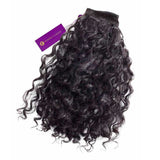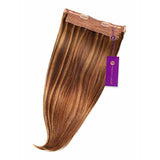Finding Hair Solutions During Your Alopecia Journey
Tape in extensions for alopecia can be a suitable option for those with certain types of hair loss, depending on several factors:
- Best for: Mild to moderate hair loss, patchy alopecia areata, androgenetic alopecia
- Not recommended for: Active shedding, severe inflammation, alopecia totalis/universalis
- Installation: Professional application using medical-grade adhesive
- Maintenance: Move-ups every 4-6 weeks, gentle care with sulfate-free products
- Safety considerations: Requires sufficient natural hair for attachment, patch testing for adhesive allergies
Experiencing hair loss can be emotionally challenging, affecting not just your appearance but also your confidence. If you're navigating the complex journey of alopecia, you're not alone—approximately 40% of women experience visible hair loss by age 40. While medical treatments address the underlying causes, tape-in extensions offer an immediate solution to restore volume and length.
I'm Priyanka Swamy, founder and CEO of Perfect Locks, and I've spent over 15 years helping women with various hair challenges, including developing gentle tape in extensions for alopecia that provide natural-looking results without causing further damage.
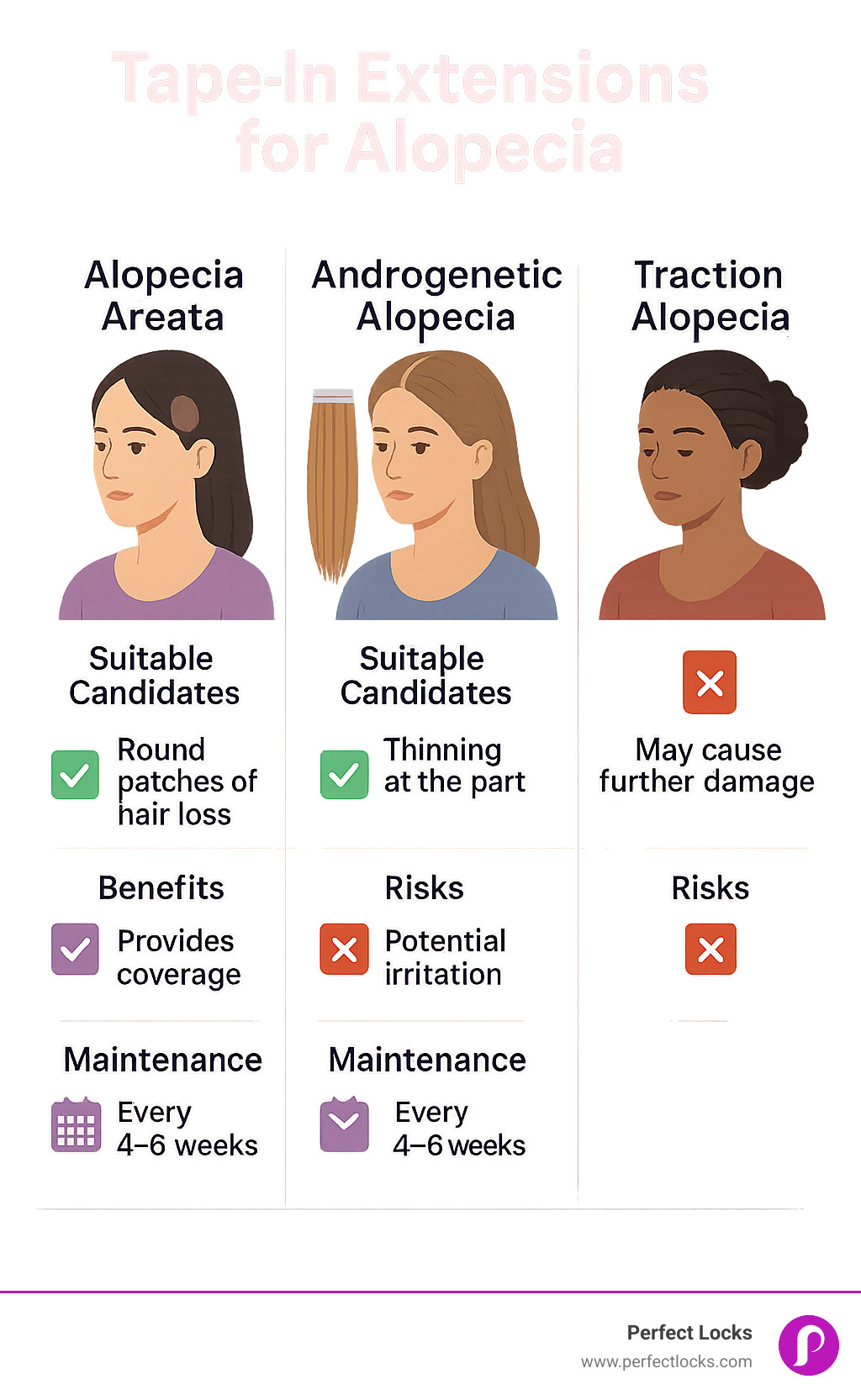
Understanding Alopecia: Types, Causes & Candidacy
Before exploring extension solutions, understand what type of alopecia you're experiencing. This knowledge is crucial in determining whether tape in extensions for alopecia are right for your specific situation.
Alopecia isn't just one condition—it comes in several forms, each with unique characteristics. Alopecia areata appears as round, coin-sized patches of hair loss when your immune system mistakenly attacks hair follicles. These patches might show up suddenly, sometimes growing larger or smaller over time.
Androgenetic alopecia, commonly known as pattern baldness, affects both men and women but presents differently. Women typically experience gradual thinning across the crown and along the part line rather than a receding hairline. This hereditary condition is influenced by hormones and genetics.
Traction alopecia results from prolonged tension on your hair follicles—think tight ponytails, braids, or even previous extensions that weren't properly applied. The good news? If caught early and the source of tension is removed, this type can often be reversed.
For those with alopecia totalis or universalis—more severe forms where all scalp hair or all body hair is lost—tape-in extensions aren't typically suitable, and alternative solutions like wigs might be more appropriate.

The causes behind your hair loss can vary widely—from autoimmune triggers to hormonal shifts during pregnancy, menopause, or due to thyroid conditions. Stress, certain medications, and even nutritional deficiencies can also play a role. That's why we always recommend consulting with a dermatologist before considering extensions. A proper diagnosis helps ensure you're addressing the underlying cause while exploring cosmetic options that won't compromise your hair's health.
Research from the Cleveland Clinic on alopecia areata provides valuable insights into the autoimmune nature of this condition and potential treatment approaches that might complement your extension journey.
When Is Your Scalp Ready for Extensions?
Not everyone with alopecia is an immediate candidate for tape-ins. Your scalp needs to be in the right condition to ensure extensions help rather than harm your hair journey.
If you're currently experiencing active shedding—more than 125 hairs per day—it's best to wait. Adding extensions during this phase might accelerate hair loss and create more emotional stress than relief. Similarly, any signs of inflammation like redness, scaling, persistent itching, or pain indicate your scalp needs healing time before considering extensions.
Density matters too. For tape-ins to blend naturally and attach securely, you need at least 50% of normal hair density. A professional stylist can assess this using what we call the "ponytail test," examining how much natural hair you have to work with.
Stability is another key factor—ideally, your hair loss should have plateaued for at least three months before applying extensions. This waiting period helps ensure you're not attaching extensions to hair that might soon fall out.
Your overall scalp health plays a crucial role too. Before application, your scalp should be clean, dry, and free from excessive oils or product buildup that might interfere with adhesion.
The bottom line? A professional evaluation by a dermatologist or trichologist and an extension specialist who understands alopecia is the best way to determine if you're ready for tape-ins. They'll examine your specific hair loss pattern, scalp condition, and overall hair health to recommend the most appropriate solution for your unique situation—whether that's tape-ins now or another approach while your scalp heals.
Tape-In Extensions for Alopecia: Benefits, Risks & Installation
Tape in extensions for alopecia use ultra-thin wefts with medical-grade adhesive that “sandwich” a small slice of your own hair, adding instant fullness without bulky beads or tight stitching.
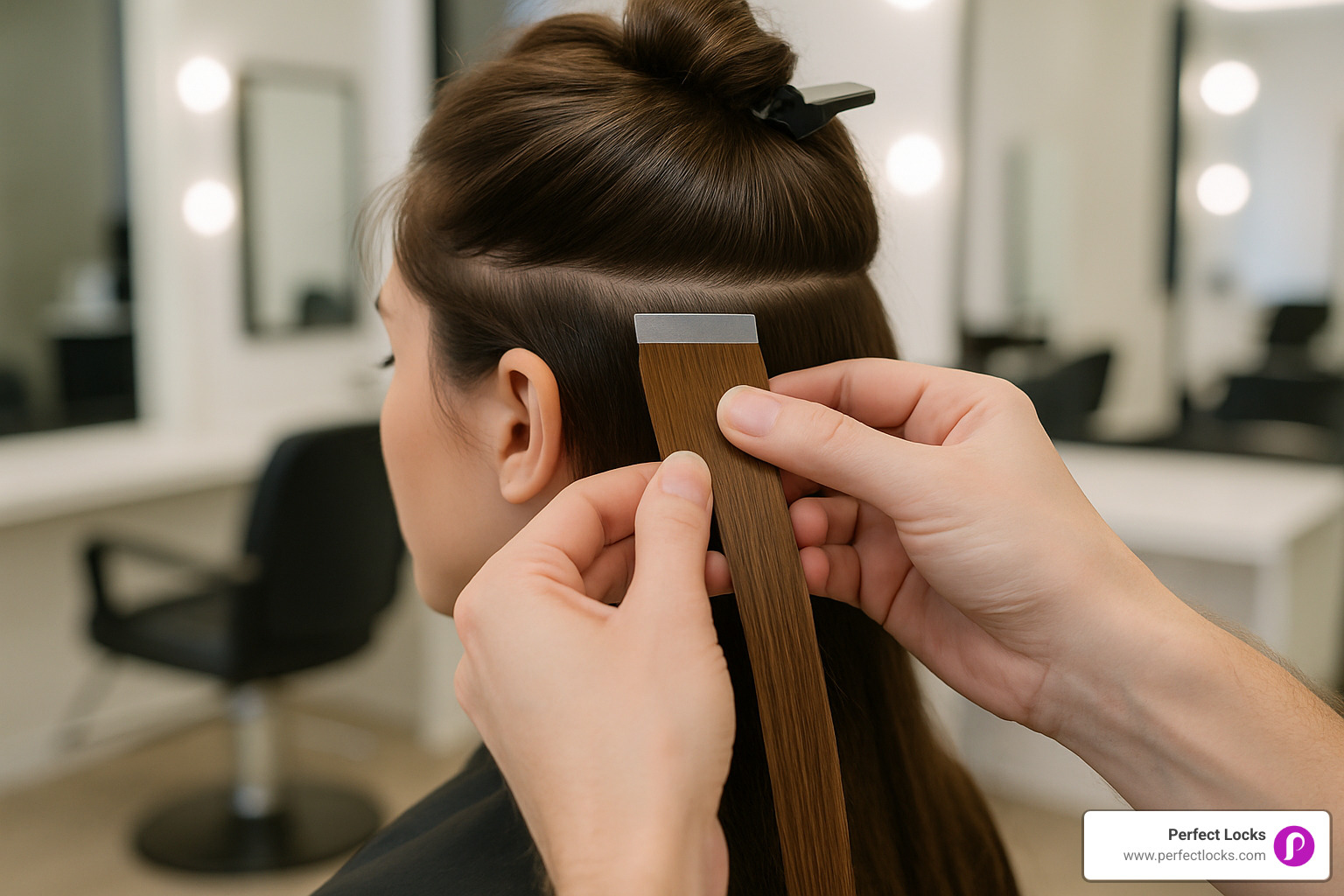
Because weight is spread over a wider area, tape-ins are gentler than many alternatives—crucial when follicles are already compromised. A typical appointment looks like this:
- Consultation and color/texture match
- 1-2-hour installation
- Move-ups every 4–6 weeks
- Full removal or replacement after 3 cycles (about 3–6 months)
Costs depend on the number of wefts (30–60 for full coverage), hair quality (100 % Remy is best), and stylist expertise.
Key Benefits
- Flat, lightweight wefts move naturally with your own hair
- Versatile styling: heat tools, ponytails, up-dos remain possible
- Reusable hair—up to three wears when properly cared for
- Short salon time and, most importantly, a quick confidence boost
Risks & Contraindications
- Possible adhesive allergy—always patch-test 48 hours prior
- Too many wefts = extra weight; an alopecia-savvy stylist will limit pieces
- DIY application/removal increases breakage and traction alopecia risk
- Not advised when loss is active, scalp is inflamed, or density is <50 %
Avoid tape-ins if you have alopecia totalis/universalis or a history of adhesive reactions.
Installation & Removal Basics
Hair is clarified, dried, then sectioned into ¼-inch slices. One weft is placed underneath, a second on top, and gentle pressure seals the bond—staying away from fragile hairline and nape. For removal, a professional solvent dissolves the tape in 30–60 seconds; wefts slide off, residue is shampooed away, and a one-week “scalp vacation” lets follicles rest before re-application.
Perfect Locks’ tape-ins are made with medical-grade adhesive and ethically sourced 100 % Remy hair, so you get salon quality without sacrificing scalp health.
How Tape-Ins Stack Up Against Other Hair Solutions
When exploring tape in extensions for alopecia, it's important to understand how they compare to other hair improvement options. Each solution offers different benefits depending on your specific needs and lifestyle.
| Method | Weight/Tension | Application Time | Longevity | Reusability | Best For | Not Ideal For |
|---|---|---|---|---|---|---|
| Tape-Ins | Low-Medium | 1-2 hours | 4-6 weeks | Yes (3 cycles) | Patchy loss, thinning | Active shedding, severe loss |
| Clip-Ins | Medium | 5-15 minutes | Daily removal | Yes (6-12 months) | Temporary use, DIY | Daily wear, sensitive scalps |
| Sew-Ins | High | 2-4 hours | 6-8 weeks | Yes (6-12 months) | Thick, resilient hair | Fine/fragile hair, sensitive scalps |
| Keratin Bonds | Low | 3-5 hours | 3-4 months | Depending on maintenance | Precise placement | Oily scalps, chemical treatments |
| Toppers | None-Low | 2-5 minutes | Daily removal | Yes (8-12 months) | Crown/part thinning | Full-head coverage needs |
| Wigs | None | 2-5 minutes | Daily removal | Yes (1-2 years) | Complete coverage | Active lifestyles, hot climates |
| Halos | None | 2 minutes | Daily removal | Yes (6-12 months) | Sensitive scalps | Front hairline thinning |
I've seen many clients transition between different solutions as their hair journey evolves. Sarah, a client with androgenetic alopecia, started with tape-ins when her thinning was minimal, then incorporated a topper as her crown thinning progressed. This flexibility allowed her to maintain her confidence throughout her hair loss journey.
What makes tape in extensions for alopecia stand out is their balance between longevity and gentleness. Unlike clip-ins that require daily handling (potentially causing stress on fragile hair), tape-ins stay put for weeks. Yet they don't create the intense tension that sew-in methods might, which can be problematic for those already experiencing hair loss.
Choosing the Gentlest Option for Your Alopecia Type
Finding the right solution depends heavily on your specific alopecia pattern and severity. Here's what I typically recommend to my clients:
For Alopecia Areata with its characteristic patchy loss, strategically placed tape-ins work wonders to cover specific spots while being gentle on surrounding hair. I've seen remarkable changes where just a few well-placed wefts completely disguise quarter-sized patches. If your patches are concentrated at the crown, a topper might be more suitable, or clip-ins for those who only need coverage occasionally.
When dealing with Androgenetic Alopecia and its progressive thinning pattern, tape in extensions for alopecia distributed throughout thinning areas create beautiful, natural-looking volume. Many of my clients with this type find that 30-40 wefts spaced strategically give them back the fullness they've lost. For those with primarily crown and part-line thinning, a well-matched topper often provides the most natural result with minimal manipulation of existing hair.
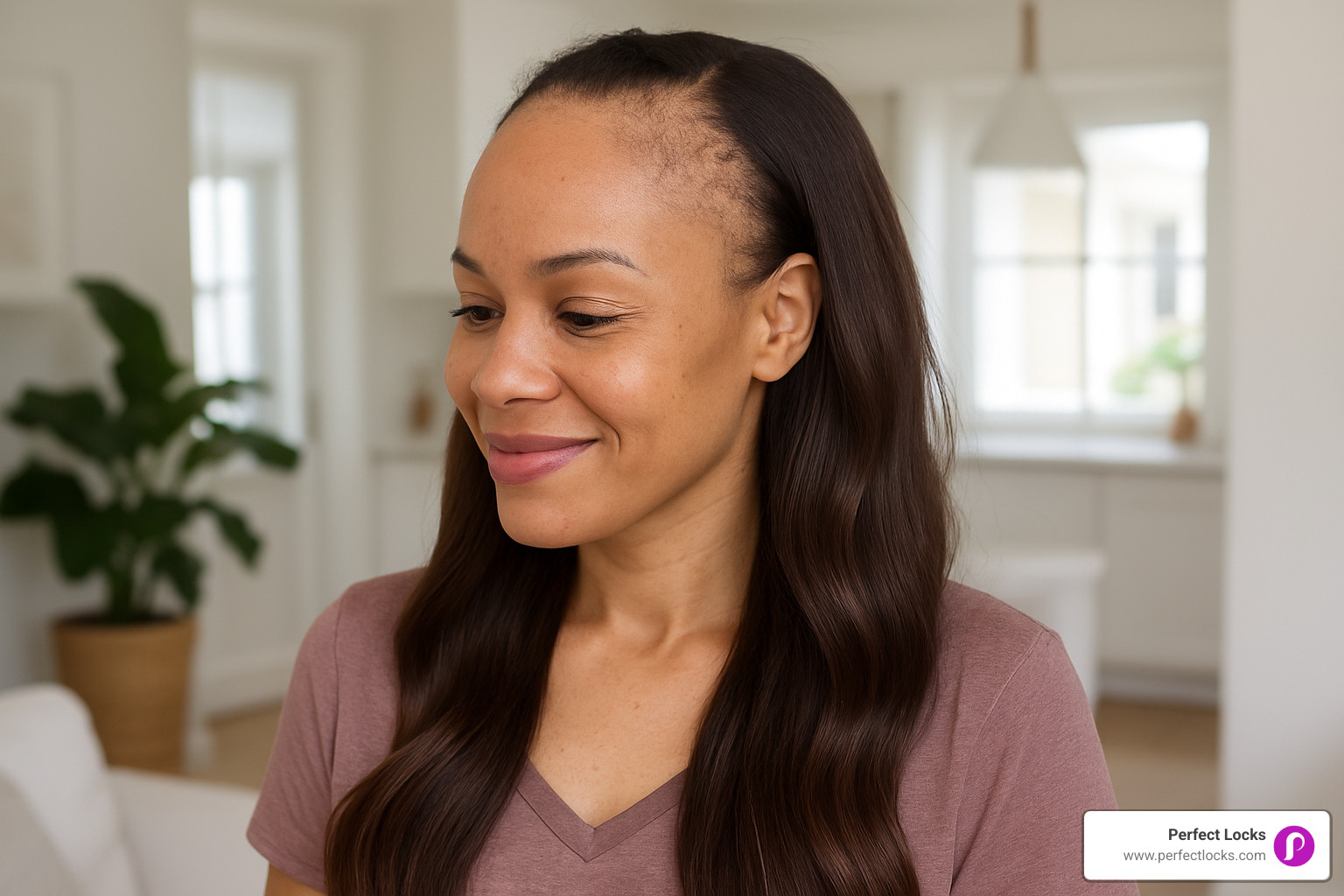
For those with Traction Alopecia, I always emphasize healing first. Halo extensions are my go-to recommendation since they add volume without any attachment to your natural hair. They literally sit on your head like a headband with hair attached. Once the damaged areas have recovered, very light tape-ins placed away from previously affected areas can be considered, but with extreme caution.
In cases of Alopecia Totalis or Universalis where hair loss is complete or nearly complete, full wigs with comfortable caps provide the most comprehensive solution. Some clients with minimal remaining hair find that adhesive toppers can work if they have enough anchor points.
At Perfect Locks, we often create customized combination approaches for complex cases. One of my favorite success stories involves a client who used tape-ins for areas with sufficient density while incorporating a small topper for crown coverage. This custom approach gave her the most natural results while protecting her remaining hair. The beauty of this approach is that as your hair situation changes, your solution can evolve with it.
Many clients find that hair extensions for bald spots require some experimentation to find their perfect match, and that's completely normal. Your hair journey is unique, and finding the right solution often involves trying different approaches until you find what works best for your specific situation, lifestyle, and comfort level.
Maintenance, Care & Warning Signs
Alopecia makes gentle maintenance non-negotiable. Follow these core rules to protect both your extensions and the hair you still have.
- Brush morning and night with an extension-safe brush, starting at the ends.
- Wash every 2–3 days with sulfate-free shampoo; stroke downward and keep conditioner and oils away from tape bonds.
- Use heat tools sparingly—always with protectant and at least 1 inch from the tabs.
- Schedule professional move-ups every 4–6 weeks; replace tape after 2–3 cycles and let your scalp rest 1–2 weeks between sets.
Red Flags—Remove Immediately
Persistent itching, pain, rash, visible pulling, sudden shedding, slippage, or root matting all signal it’s time to see your stylist and likely remove the extensions.
Finding an Alopecia-Savvy Stylist
Look for tape-in certification plus documented experience with clients who have hair loss. Key questions:
- How many alopecia clients have you served?
- Which medical-grade adhesive and patch test do you use?
- How do you determine safe weft count & placement?
A true pro will put hair health first—and will say “not now” if your scalp isn’t ready. Perfect Locks can connect you with vetted stylists throughout the Bay Area, California, and beyond.
Frequently Asked Questions about Tape-In Extensions for Alopecia
Can tape-ins worsen hair loss?
They can if they’re too heavy, applied during active shedding, or removed improperly. A skilled stylist limits weight, places wefts away from fragile zones, and performs regular maintenance, making tape-ins safe for most mild-to-moderate cases.
How often do I need move-ups or new tape?
Book move-ups every 4–6 weeks so tabs stay close to the scalp and tension stays low. Replace the adhesive after 2–3 move-ups; quality wefts can be reused for up to three cycles (about 9-12 months).
What if my alopecia is advanced?
For widespread loss, consider lightweight halo extensions, breathable toppers, or full wigs instead of tape-ins. Perfect Locks offers all three, and many clients combine methods—tape-ins where density allows, a topper or wig where it doesn’t.

Conclusion
Living with alopecia presents unique challenges, but it doesn't mean giving up on having beautiful, confidence-boosting hair. Tape in extensions for alopecia offer a viable solution for many—providing immediate volume, versatile styling options, and natural-looking results when properly applied and maintained.
The journey through hair loss can feel isolating, but you're not alone. Millions of women steer similar paths every day, finding solutions that work for their unique situations. What matters most is finding an approach that helps you feel like yourself again.
Getting properly diagnosed by a dermatologist should always be your first step. Understanding the specific type and cause of your hair loss creates the foundation for making informed decisions about extension options. Some alopecia conditions respond well to medical treatments, while others benefit from cosmetic solutions like extensions—and many people find success with a combination approach.
Working with an experienced professional who truly understands the nuances of applying extensions to thinning hair is essential. The right stylist will prioritize your scalp health above all else, recommending appropriate techniques based on your specific needs. They'll know when tape-ins are right for you and when to suggest alternatives.
Maintaining proper care routines protects both your extensions and your natural hair. Those gentle daily habits—from how you brush to how you sleep—make all the difference in preserving your investment and preventing further damage.
Most importantly, listen to your body. Monitor your scalp health regularly and be willing to adjust your approach if you notice any concerning signs. There's no shame in trying different solutions until you find what works best for you.
At Perfect Locks, we're committed to providing premium, ethically sourced human hair extensions that help restore not just your hair, but your confidence. Our team understands the emotional impact of hair loss and works with you to find solutions that meet both your aesthetic desires and health needs.
Your hair journey is personal, and there's no one-size-fits-all solution. Whether tape-ins are right for you or another method better suits your needs, embracing the options available can help you feel like yourself again—because beautiful hair should be accessible to everyone.
For more information about our tape-in extensions and other hair loss solutions, visit our tape-in hair extensions collection or schedule a consultation with one of our specialists.










